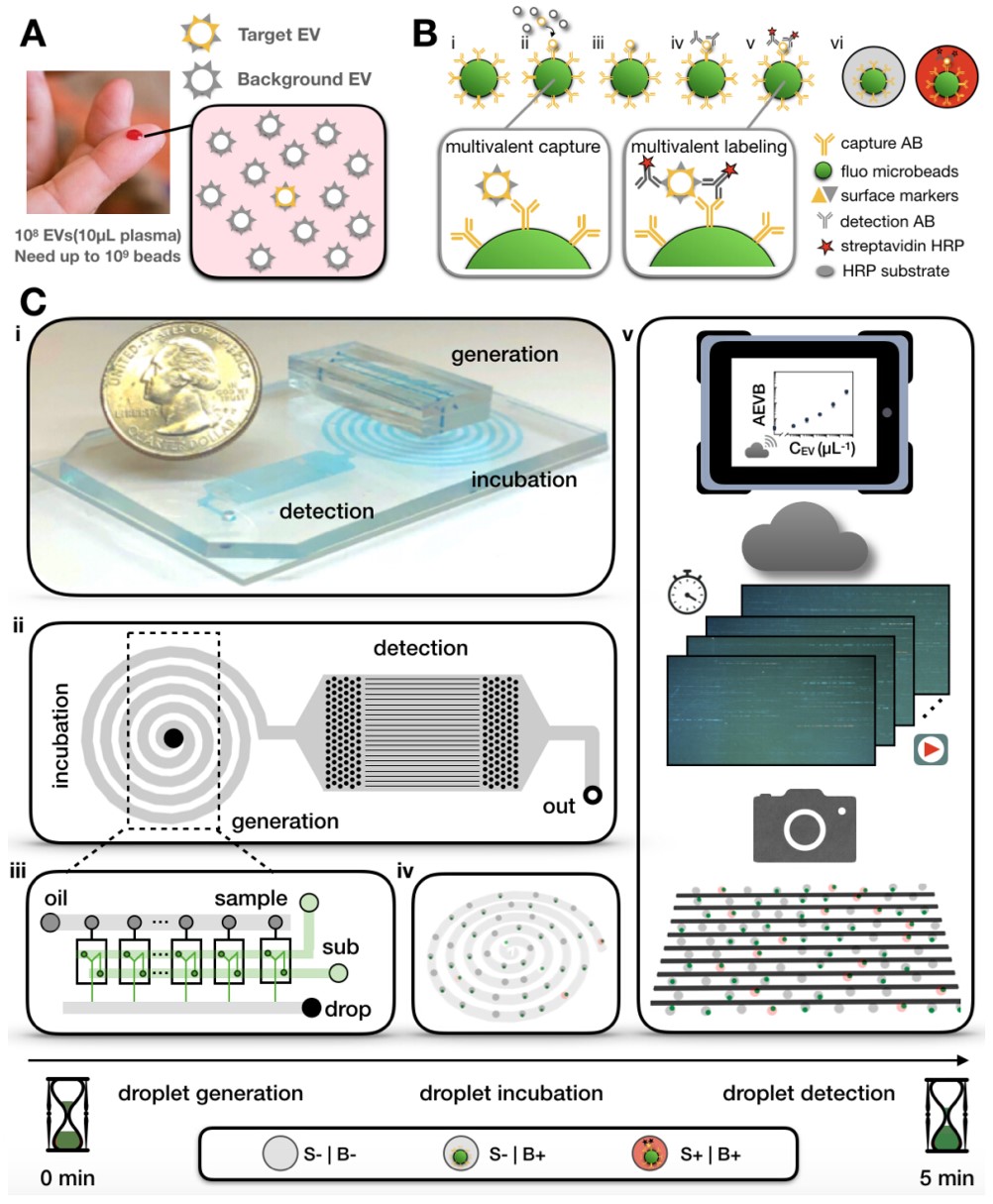An optofluidic platform to detect extracellular vesicles (EVs) at the single-particle level by parallelizing droplet generation and analysis of EVs.
Problem:
Extracellular vesicles (EVs) are lipid bound nanomaterials carrying various molecular cargo that can be representative of their cells of origin. EVs play a critical role in intercellular communication and have enormous potential as biomarkers for a wide range of biomedical applications. Because EVs are heterogenous, there has been an effort to measure EVs at the single particle resolution. However, current assays for EV detection do not have the sensitivity to detect individual nanoscale EVs, lack the specificity to distinguish EV subpopulations, and have insufficient throughput to probe rare EV subpopulations.
Solution:
The Droplet-based Extracellular Vesicle Analysis (DEVA) platform is a high-throughput, ultrasensitive digital assay that can quantify rare EV subpopulations at the single particle resolution by capitalizing on the parallelization of droplet generation, processing, and analysis of EVs.
Technology:
The DEVA assay uses fluorescent paramagnetic microbeads conjugated to a capture antibody that binds to the surface protein of EV subpopulations from samples. Captured EVs are further processed by ELISA (enzyme-linked immunosorbent assay), where they are labeled with a biotinylated antibody and streptavidin-horseradish peroxidase (HRP) enzyme to form enzyme-linked immunocomplexes. The EV-bead immunocomplexes are mixed with a fluorescence enzyme substrate, loaded into aqueous droplets using parallelized droplet generators, and flowed through a detector with 90 parallelized microfluidic channels where a machine vision camera records the encoded fluorescent signal (from enzyme-substrate reaction) and transfers the data to cloud computation for analysis.
Advantages:
- Achieves 100-fold improvement in throughput (~20 million drops/min) compared to standard single EV characterization methods
- Can be multiplexed to analyze >100 EV subpopulations simultaneously
- Capable of quantifying rare EV subpopulations from complex samples with high background
- Reduces the limit of detection (LOD) to 9EVs/uL, which represents a 100-fold improvement in LOD compared to the gold standard assay for EV detection
- Uses accessible and affordable optics (<$1,000) and fabrication methods

(A) Target EVs can be captured from complex samples such as plasma using DEVA. (B) Schematic of bead-based digital enzyme-linked immunosorbent assay (ELISA) for single EV detection. Fluorescent microbeads (green) conjugated with capture antibodies are used to target EV surface proteins. Targeted EVs are subsequently labeled with biotinylated antibody and streptavidin-HRP enzyme to enable fluorescence detection (red). (C) (I) Miniaturized microfluidic platform for DEVA that integrates droplet generation, incubation, and detection. (II) All droplets flow through a delay line chamber for incubation to enable fluorescent signal generation before flowing through a detection section consisting of 90 parallelized microfluidic channels. (III) A parallelized flow focusing droplet generator that encapsulates the beads into droplets. (IV) The EV-bead immunocomplex turns the droplet fluorescent during the incubation in the delay line. (V) A machine vision camera records the fluorescent signals from the immunocomplexes that flow through the 90 parallelized microfluidic channels in the DEVA’s detection segment. S: substrate, B: beads. S+ B+ is a droplet with a signal originating from both substrate and bead. S- B+ represents a droplet containing a bead without detection signal. S- B- refers to a blank droplet. Parallelization of droplet generation, incubation, and detection enables a throughput of ~20million droplets/minute.
Case ID:
22-10061_tpNCS
Web Published:
2/26/2024
Patent Information:
| App Type |
Country |
Serial No. |
Patent No. |
File Date |
Issued Date |
Expire Date |